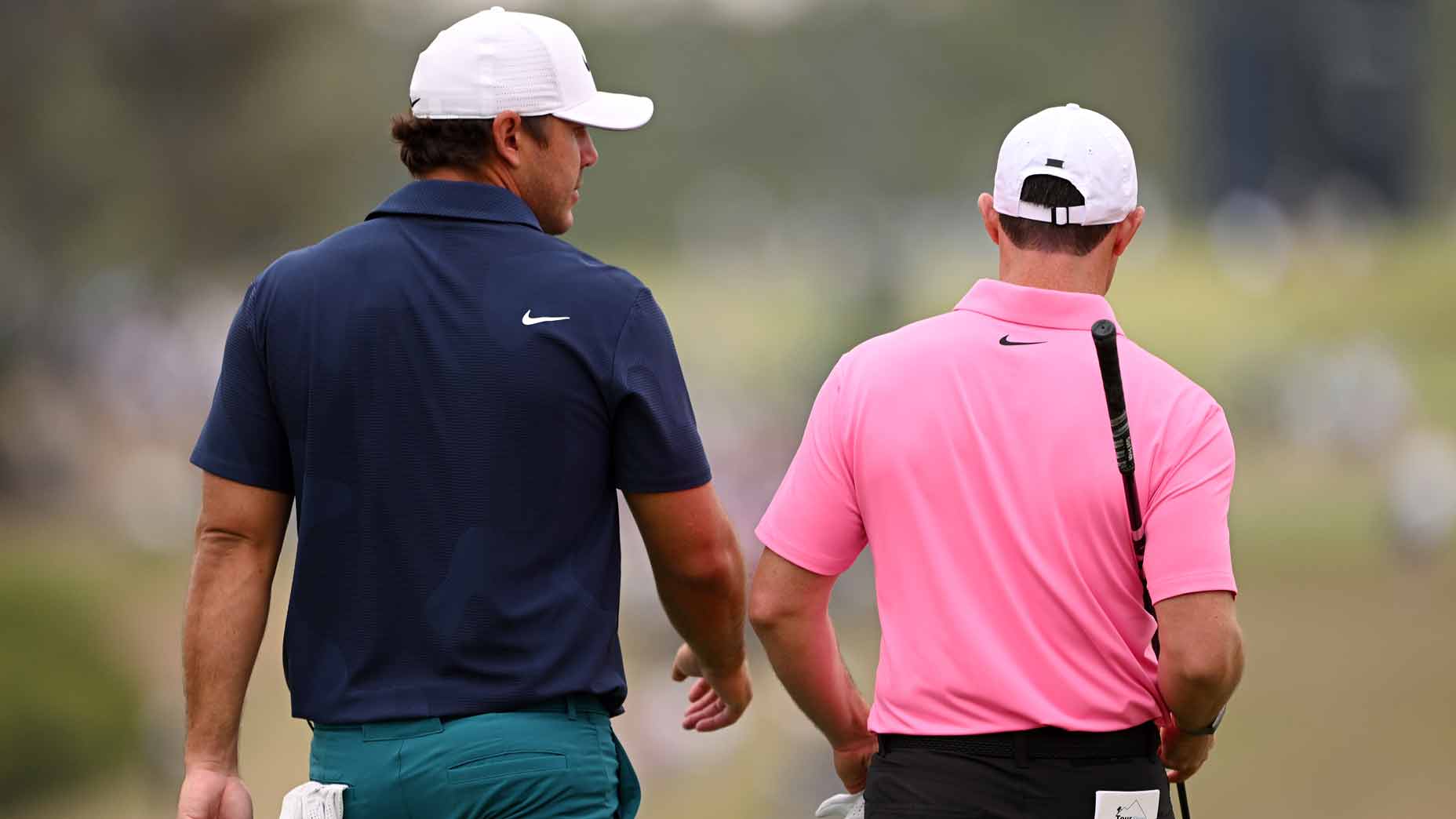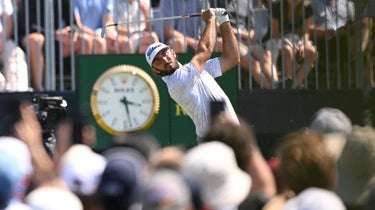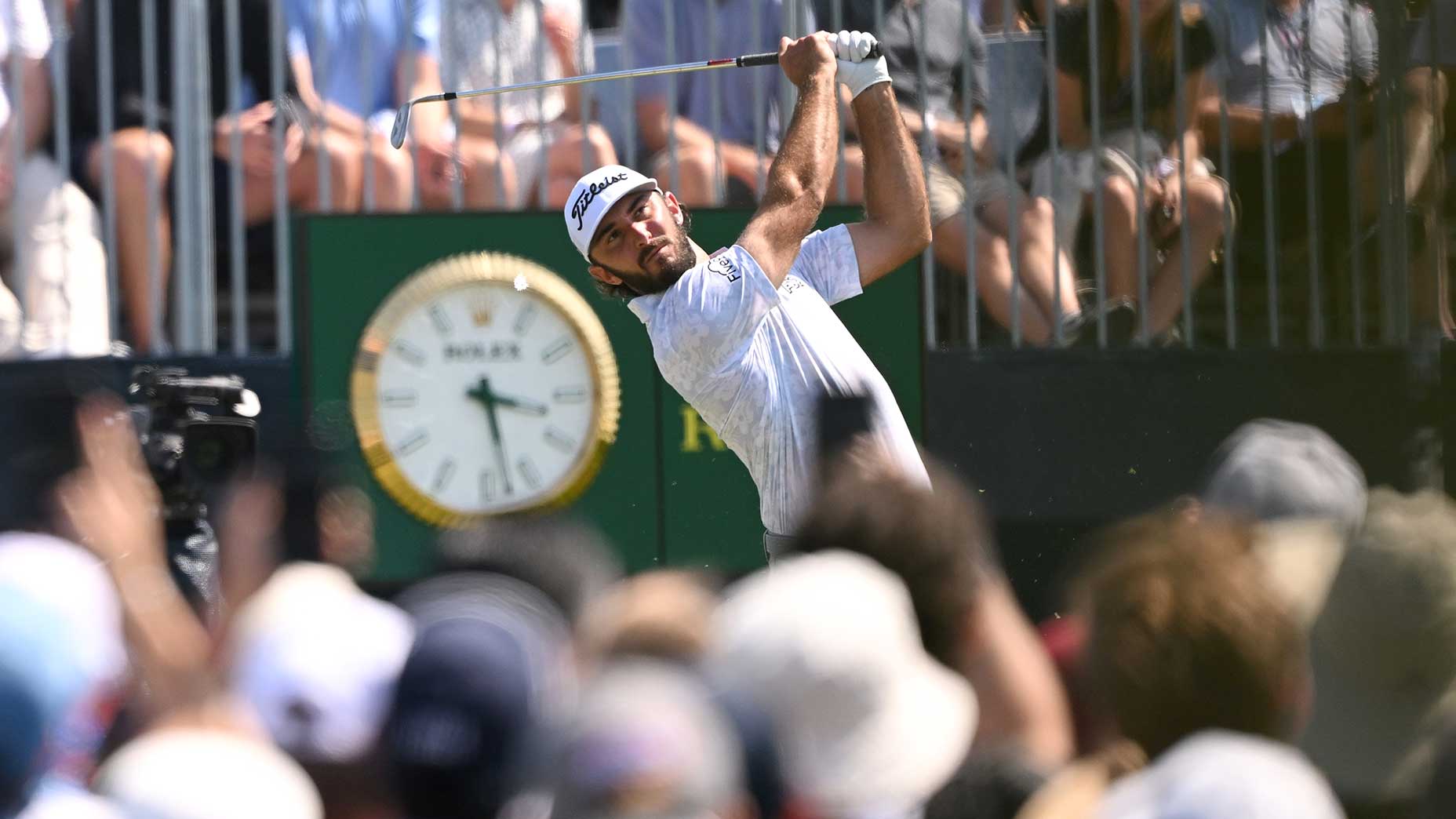
Rory McIlroy and Brooks Koepka played together Thursday and Friday at the U.S. Open.
Getty Images
LOS ANGELES — The green at Los Angeles’ 221-yard par-3 4th was occupied, so the group on the tee had time to kill.
Ricky Elliott, caddie to Brooks Koepka, began unloading clubs from his bag. One wedge, then another, then another. Once he’d cleared enough space he flipped one of the clubs over and started probing at the bottom of his bag, a surgeon with his scalpel. After a few moments the club reemerged, a long-lost towel deftly attached.
Elliott proudly showed his prize to Koepka and Rory McIlroy, who cracked up at the satisfaction on his face. Forget the nine combined majors. Forget the millions. Forget the tour-vs.-tour divide. Forget the legacy-changing major championship at stake. For a moment this was just a couple buddies yukking it up, waiting for the green to clear.
Even before the USGA paired ’em together for the first two rounds of this week’s U.S. Open, the sight of Koepka and McIlroy together had become increasingly common. They’d seen each other for lunch in Jupiter. They played a practice round at the Masters. After Koepka’s win at the PGA Championship, there was McIlroy, offering a congratulatory hug. Was their friendship an early sign of improving LIV-PGA Tour relations? A natural kinship between the two greatest major champions since Tiger Woods? Just two neighbors who missed playing golf together?
Who could say! But as I watched them walk up one fairway together, comparing notes on some mystery topic, I couldn’t help but think it’s a perfect match. If who you spend time with is who you become, that’s good news for McIlroy — and for Koepka, too. Because each is at his best when he’s borrowing from the other.
Let’s start with McIlroy, who was a little spicy coming into the press room on Friday afternoon. He’d nearly jarred his final swing of the day, his tee shot at the par-3 9th, before canning his birdie putt to finish off a round of three-under 67 that put him just two shots back of the 36-hole lead.
One reporter pointed to the scoring, unusually low for a U.S. Open — Rickie Fowler leads at 10 under par — and asked whether that benefitted McIlroy’s golf game, citing the fact that he’s never won an event when the winning score was single-digits under par.
McIlroy had none of it.
“So, if I had shot single-digits under at Congressional I would have won,” he said, a callback to his win at the 2011 U.S. Open, where he shot 16 under par while runner-up Jason Day finished second at eight under. In other words, if he’d won by a single shot, he would have won in single digits. Instead he won by eight. “If I would have shot single digits under at Kiawah, I would have won,” he added. Same deal: at the 2012 PGA, McIlroy shot 13 under par, eight shots ahead of runner-up David Lynn. “So I think it’s a flawed statistic.”
Then he looked back to the moderator. Next question.
Remind you of anyone?
Just a few moments earlier, Koepka — who shot 69 and sits eight shots back of McIlroy — had spoken to the media and shared some characteristically candid thoughts of his own:
“I’m not a huge fan of this place,” he said. “I think it would be more fun to play on just like a regular round than it would be a U.S. Open. I mean, there’s, what, two [rounds of eight under] yesterday. That doesn’t happen.”
An honest answer. An insightful answer. And the answer of a man who doesn’t care what you think about what he had to say.
Any player would obviously do well to steal some of Koepka’s major-championship mojo; those five trophies speak for themselves. But McIlroy has all the golfing tools, which means he just needs a sprinkle of Koepka’s superpowers. It’s the little stuff. It’s the unshakeable confidence. It’s the patience. It’s the tunnel vision. It’s the ethos of looking out for No. 1, knowing that’ll take care of everything else.
One obvious example of McIlroy becoming slightly more Brooksy is his shift in handling golf’s geopolitical landscape. In the 12 months since Koepka left for LIV, McIlroy has spoken up again and again and again on behalf of the PGA Tour, shouldering a larger burden than any other individual in the game. Koepka has shrugged off questions, dismissed the drama as “just golf” and downplayed any complicating factors. But beginning at the PGA McIlroy made it clear he’s done giving answers that’ll add distractions. He canceled his pre-tournament press conference at the U.S. Open. He skipped media after his first-round 65, too. And he won’t speak on pro golf’s big-picture future until after the last putt has dropped on Sunday — and even then, who knows?
Professional golf is a game of handling distractions. McIlroy has shown he can juggle distractions. He can harness them. But there’s nobody better at eliminating them than Koepka — who offered a useful window into his mindset before this week’s event.
“The more chaotic things get, the easier it gets for me,” he said. “Everything starts to slow down and I am able to focus on whatever I need to focus on while everybody else is dealing with distractions, worried about other things.”
He provided a specific example from the 2018 U.S. Open at Shinnecock, when Zach Johnson’s “they’ve lost the golf course” speech kicked off a day of players wondering whether conditions had gotten too extreme.
“Everybody was bitching, complaining,” Koepka remembered. “I just felt like they were all so focused on the golf course they kind of forgot about what was going on, that they were there to play a major championship instead of, ‘Okay, the greens are pretty fast.’
“But if you leave yourself with an uphill putt, it’s not too bad.”
Needless to say Koepka went on to win. He won because of his golf game, of course. But he also won because he does an elite job of simplifying complex things. That plays well at every major.
In recent years there’s no question Koepka has been the superior major champion of the two; all four of McIlroy’s majors came before Koepka’s first. And, if McIlroy needed any extra motivation (we doubt it), Koepka’s victory at last month’s PGA gave him the 5-4 career edge. Beating Koepka in the first two rounds of this year’s U.S. Open doesn’t change that tally even a little bit. But it must have been satisfying nonetheless.
McIlroy’s Friday round was impressive not because of how he started but because of how he finished. McIlroy played his first nine holes in two-over 37 before rallying with six birdies on his second nine to post 67, among the lowest rounds of the day, and climb to T3 in the process. His day was a masterclass in driving; he was sixth in driving distance while missing only two fairways. He was a man in control.
After their rounds, Koepka was Koepka and Rory was Rory.
“I guess I just didn’t play that great, so not going to really shoot a good number,” Koepka said matter-of-factly.
McIlroy, on the other hand, waxed poetic. He explained his strategy with a story about a recent trip down memory lane. Once he’s at a microphone he can’t help but offer insight. It’s in his nature to let us in.
“For whatever reason I went onto YouTube a few weeks ago and was just looking back at like, Hoylake in 2014 and I actually couldn’t believe how many irons and 3-woods and stuff I was hitting off the tee,” he said. “It set something off in my mind about, you know how to do this. You know how to play smart. You don’t have to hit driver all the time. Yes, it’s a big weapon, it’s a big advantage. But I keep saying I’ve got more weapons in my arsenal, I feel, now than I did back then, so I may as well use them and play to them.”
He cited the Memorial two weeks ago as an example of a tournament where he lacked patience. That’s a word thrown around every year at major championships and it’s a trait Koepka has in greater supply than perhaps any other golfer of his generation. That’s a funny thing about golf; in some sports machismo presents itself as power, size or strength but in this one it comes from patience.
Ultimately, McIlroy wants what Koepka now has: a fifth major championship. But that doesn’t mean he’s the only one borrowing here.
Over the past year Koepka has learned more about his own vulnerability. He’s battled injury and uncertainty. And when he returned to the mountaintop, first in a runner-up Masters finish and then in his triumph at Oak Hill, he was a more meaningful champion because he let us in. He didn’t get an extra trophy for telling his story, but his win was most impactful and more powerful as a result. I’m not suggesting he spoke out because he was copying McIlroy, but doing so left fans in the same satisfying place: a superstar athlete bringing us with him on a complex, triumphant journey to the top.
Early this week Koepka was asked which of his five major championships was his favorite. He didn’t hesitate.
“This last one, for sure,” he said. “They all mean something different, but this last one, for all the stuff I had to deal with, all the pain, the tears, all the stuff that went into it…”
As for McIlroy’s favorite? I’m willing to bet it’ll be the next one.









